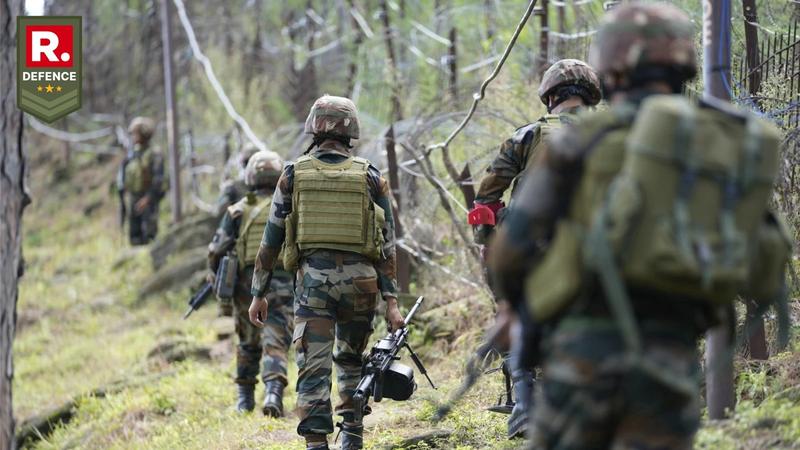Published 18:50 IST, December 25th 2024
LoC Operations: Indian Army’s Multifaceted Approach to Securing Jammu and Kashmir's Rugged Border
The Line of Control (LoC) in Jammu and Kashmir, spanning over 740 km, is one of the world’s most heavily militarized borders.

Kashmir, India - The Line of Control (LoC) in Jammu and Kashmir, stretching over 740 kilometres, represents one of the most volatile and militarized borders globally. This rugged terrain demands exceptional adaptability from the Indian Army, whose operations encompass defensive measures, offensive strategies, and specialized actions in diverse environments such as dense forests, urban areas, and glaciated regions. The unique challenges posed by geography, weather, and enemy tactics are countered through meticulous planning, modern technology, and unmatched resilience.
Defensive Tactics
The Indian Army's defensive operations along the LoC are anchored in a multi-layered strategy. Posts are positioned on dominating heights to monitor enemy activities and deter infiltration attempts. These outposts, integrated with advanced observation systems, include fortified living quarters, communication centres, and fighting bunkers designed to withstand prolonged enemy fire. Infiltration deterrence is prioritized, with robust wire obstacles, night surveillance equipment, and human intelligence networks working in tandem.

Patrolling remains a cornerstone of the defence. Regular movement through nullahs, ridgelines, and vulnerable gaps ensures territorial integrity and discourages adversary exploitation of weak points. The Advanced Integrated Observation System (AIOS) further enhances situational awareness by combining electronic surveillance with thermal imaging, reducing dependence on physical patrols during adverse weather.
- Each post includes specific facilities such as fighting bunkers, living quarters, and observation posts, all fortified to withstand direct enemy fire or sniping.
- Integrated stone walls, Punji traps, and concealed bunkers are essential to minimize vulnerabilities.
Countering Infiltration
- Surveillance and Patrolling: Using UAVs, night vision devices, and consistent patrols near gaps in the fence.
- Electronic Surveillance: Deployment of sensors, thermal imaging devices, and other technological aids.
- Population Control Measures: Close monitoring of villages along the LoC to detect Ground Workers (OGWs) or facilitators.

Countering Challenges
- Responding to ceasefire violations (CFVs), sniping, shallow infiltrations, and sneak raids remain a priority.
- Tactical response teams (QRTs) are stationed to counter unexpected threats, ensuring rapid reinforcement when needed.
Offensive Strategies
Offensive operations along the LoC are characterized by precision and rapid execution. Initiatives such as targeted strikes and coordinated assaults leverage artillery and infantry units. Before launching an attack, the Indian Army establishes firm bases, ensuring operational stability and effective resupply mechanisms. Artillery bombardments weaken enemy defences, paving the way for infantry to advance.
Offensive operations involve firm base establishment, followed by infiltration of enemy areas through multi-directional assaults. Artillery and mortars are employed to suppress enemy defences before launching infantry attacks.

The deployment of specialized units, such as the Indian Army’s Para Commandos, ensures swift and targeted actions in enemy territory. Such operations disrupt adversary supply chains, degrade command networks, and neutralize high-value targets. These offensive measures, combined with intelligence-driven decision-making, sustain dominance along the LoC.
High Mobility and the Use of Special Forces
Special attention is given to maintaining momentum, ensuring quick movement despite challenging terrains. Surprise and deception are vital, with operations often coordinated during adverse weather to limit enemy responses.
Specialized units conduct precision strikes, often deep inside the enemy-held territory, targeting critical nodes such as logistics depots or command centres.
Glaciated Terrain Operations
The glaciated regions near the Actual Ground Position Line (AGPL), including the Siachen Glacier, present unparalleled challenges. Soldiers operate at altitudes exceeding 19,000 feet, braving temperatures that plummet below -40°C. The terrain itself, with steep gradients, deep crevasses, and frequent avalanches, imposes severe mobility restrictions.

To counter these conditions, soldiers undergo rigorous acclimatization and specialized training in ice craft, crevasse crossing, and high-altitude survival. Defensive positions in this terrain are heavily fortified to resist both natural elements and enemy assaults. Frequent rotation of troops mitigates the physical and psychological toll of high-altitude warfare.
Forest and Urbanized Operations
In regions such as Poonch, Uri, and Kupwara, thick forests and valley-based settlements complicate military operations. These areas provide cover to infiltrators and necessitate vigilance through ambushes, small-unit tactics, and persistent reconnaissance. Urbanized zones, including cities like Srinagar, demand even more precision to minimize civilian casualties and property damage.

The Indian Army employs small, agile teams for urban operations, supported by drones and close-range surveillance. Infiltration routes are constantly mapped and monitored, while Over Ground Workers (OGWs) facilitating enemy activity are identified and neutralized.
Training and Adaptation
Training forms the backbone of the Indian Army’s operational readiness. Soldiers assigned to the LoC undergo extensive preparation in ambidextrous firing, tactical movement, and explosives handling. In glaciated regions, additional training in avalanche precautions, equipment maintenance, and emergency medical response is mandatory.
Adaptation to emerging threats is evident in the integration of modern technologies. Unmanned Ground Sensors (UGS), UAVs, and automated weaponry enhance the army’s ability to preempt and respond to adversary actions effectively.
The Indian Army’s operations along the LoC are a testament to its professionalism and adaptability. Operating in one of the world's most challenging environments, it continually evolves to counter dynamic threats while maintaining a robust defence of Indian sovereignty. By blending traditional combat expertise with cutting-edge technology and specialized training, the army ensures the security of the nation while setting new benchmarks in military excellence.
Updated 18:50 IST, December 25th 2024




